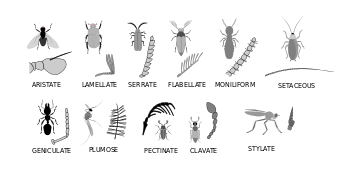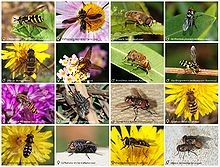Antennae (singular: antenna) in biology have historically been paired appendages used for sensing in arthropods. More recently, the term has also been applied to cilium structures present in most cell types of eukaryotes.
In arthropods, antennae are connected to the front-most segments. In crustaceans, they are biramous and present on the first two segments of the head, with the smaller pair known as antennules. All other arthropod groups â€" except chelicerates and proturans, which have none â€" have a single, uniramous pair of antennae. These antennae are jointed, at least at the base, and, in general, extend forward from the head. They are sensory organs, although the exact nature of what they sense and how they sense it is not the same in all groups, or always clear. Functions may variously include sensing touch, air motion, heat, vibration (sound), and especially olfaction (smell) or gustation (taste).
Insects>

Antennae are the primary olfactory sensors of insects and are accordingly well-equipped with a wide variety of sensilla (singular: sensillum). Paired, mobile, and segmented, they are located between the eyes on the forehead. Embryologically, they represent the appendages of the second head segment.
All insects have antenna, however they may be greatly reduced in the larval forms. Amongst the non-insect classes of the Hexapoda, both Collembola and Diplura have antenna, but Protura do not.
Structure
The three basic segments of the typical insect antenna are the scape (base), the pedicel (stem), and finally the flagellum, which often comprises many units known as flagellomeres. The pedicel (the second segment) contains the Johnston's organ which is a collection of sensory cells.
The number of flagellomeres can vary greatly, and is often of diagnostic importance. True flagellomeres have a membranous articulation between them, but, in many insects, especially the more primitive groups, the flagellum is entirely or partially composed of a flexible series of small annuli, which are not true flagellomeres.
In many beetles and in the chalcidoid wasps, the apical flagellomeres form a club, and the collective term for the segments between the club and the antennal base is the funicle; for traditional reasons, in beetles it is the segments between the club and the scape, but, in wasps, it is the segments between the club and the pedicel.
In the groups with more uniform antennae (for example: Diplopoda), all segments are called antennomeres. Some groups have a simple or variously modified apical or subapical bristle called an arista (this may be especially well-developed in various Diptera).
Functions
Olfactory receptors on the antennae bind to free-floating molecules, such as water vapour, and odours including pheromones. The neurons that possess these receptors signal this binding by sending action potentials down their axons to the antennal lobe in the brain. From there, neurons in the antennal lobes connect to mushroom bodies that identify the odour. The sum of the electrical potentials of the antenna to a given odour can be measured using an electroantennogram.
In the case of the Monarch butterfly, it has been shown that antennae are necessary for proper time-compensated solar compass orientation during migration, that antennal clocks exist in monarchs, and that they are likely to provide the primary timing mechanism for Sun compass orientation.
Crustaceans
Crustaceans bear two pairs of antennae. The first pair are uniramous and are often referred to as antennules, while the second pair are biramous, meaning that each antenna is composed of two parts, joined at their base . In most adults, the antenna are sensory organs, but they are used by the nauplius larva for swimming. In some groups of crustaceans, such as the spiny lobsters and slipper lobsters, the second antennae are enlarged, while, in others, such as crabs, the antennae are reduced in size.
Cellular antennae

Within the biological and medical disciplines, recent discoveries have noted that primary cilia in many types of cells within eukaryotes serve as cellular antennae. These cilia play important roles in chemosensation, mechanosensation, and thermosensation. The current scientific understanding of primary cilia organelles views them as "sensory cellular antennae that coordinate a large number of cellular signaling pathways, sometimes coupling the signaling to ciliary motility or alternatively to cell division and differentiation."
"Almost every vertebrate cell has a specialized cell surface projection called a primary cilium. …primary cilia are key participants in intercellular signaling. This new appreciation of primary cilia as cellular antennae that sense a wide variety of signals could help explain why ciliary defects underlie such a wide range of human disorders, including retinal degeneration, polycystic kidney disease, Bardet-Biedl syndrome, and neural tube defects."
References

